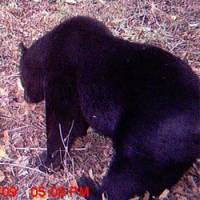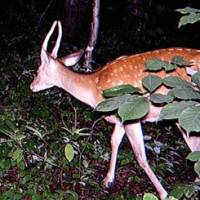Our Afan Woodland Trust here in the Kurohime hills of Nagano Prefecture has entered into a joint project with the Department of Wildlife Ecology and Management at Azabu University to study woodland biodiversity and the results of our methods of woodland management.
The research is being supervised by an old friend, Professor Seiki Takatsuki, a true hands-on conservationist and an ardent fieldworker with a rare and bubbling sense of humor. He and his team from down there in Kanagawa Prefecture have done some superbly detailed, nose-to-the-ground investigations into the flower-insect links to forest management.
To date, this research appears to be validating the practice we at Afan adopt of opening up previously untended woodland choked with dense brush in order to encourage the growth of plants that are pollinated by insects.
In other words, cutting and trimming lets in the light and allows breezes to flow. Flowers on the woodland floor attract bees, butterflies and many other insects, and these in turn bring the songbirds. With lots of careful work, the woodland then becomes alive with flowers and birdsong; you just have to let the sun shine through the upper canopy and dapple the ground with patterns of moving light by ensuring enough space for trees to grow and the wind to flow.
If the wind can't pass, how can an owl fly — or a birch seed waft on the wind?
Once humans have intervened and changed nature, then it is important that we continue to take responsibility and do our best to be a part of the cycle.
Our Afan woods are also rich in mammalian life, but as Prof. Takatsuki points out, forest mammals are essentially shy. So, when we take groups of students or other visitors through the woods, we see frogs, insects and birds — but rarely, if ever, do any mammals show themselves.
For research into these animals, we have to rely on fixed cameras positioned in the woods and triggered by movement to record what happens when humans are absent. In this way we can confirm with digital images other observations already made on the ground; scat, prints, signs of nibbling, scratching and so on.
The Azabu University team set up five of these cameras in our woods in July, and we have all been excited by the results. So far they have recorded bears, wild boars, a badger, a marten, a civet cat, a fox, squirrels and a yearling stag — the first positive evidence of deer in our woods. One camera also took a photograph of a yamadori (Japanese copper pheasant), a gorgeous mountain-dweller that's increasingly rare due to overhunting and loss of its wooded habitat.
Ever since a few years ago, when the snow cover up in these hills started to noticeably decrease, wild boars have begun to feed in our woods in winter. Native Japanese moon bears, though, have long been regular visitors — but not in winter, of course, when they are hibernating.
We knew the big bear in the picture. Both Mr. Matsuki and Mr. Ishii, our foresters, have heard him blundering through the bushes. He's the 120-kg culprit who destroyed two honeybee hives in one night, devouring all the waxen combs of honey and grubs before barging into Mr. Matsuki's forest hut, where he sniffed out a bucket of lard intended to help feed the carp in our pond. He duly gobbled all that, too — but honey, wax, grubs and fat was too rich a combination even for a rather large bear!
As a result, after he'd waddled up the mountain a bit, he vomited like a Roman senator at a banquet, overindulged in wine, fried camel hump and honey-dipped dormice. After his horrendous binge, and its regurgitatory consequences, our bear then collapsed under a tree to sleep it off.
The following day a sweet stink and the ferocious buzz of hornets led Mr. Matsuki to the spot. The bear must have heard him coming because he'd made himself scarce, leaving a large dry patch of forest floor where he had been sleeping, oblivious to the rain.
At this point I must declare that I'm not totally without sympathy for that bloated beast, because in my (well-toned) youth I once slept off a binge at the pub on Lundy, an island in the Bristol Channel between England and Wales, by lying under a potato sack in the rain outside the church. There, I woke to the brain-jarring Sunday-morning pealing of bells and disapproving murmurs from the passing congregation. But that is another story, perhaps best forgotten.
Anyway, such empathy aside, I have dubbed this trencherman ursine glutton Gerotsuke — Old Puke in Japanese.
And so on to the badger, also native to Japan and more brownish than the black, white and gray British ones I remember from my boyhood. It is called ana guma, meaning "hole bear" in Japanese, though it is not a bear but a member of the weasel family, and a quite different animal from the tanuki (raccoon dog), a folk-tale favorite most often seen in porcelain statues frequently found outside traditional drinking establishments — endowed, as the animals are said to be, with a love of sake, an enormous scrotum and the ability to shape-change. (None of this scientifically proven, mind you — but it's fun anyway.)
The Japanese language and some dictionaries can be confusing because badgers and raccoon dogs are sometimes both termed mujina. That's probably due to both animals' bandit-face stripes and the fact that raccoon dogs sometimes take over tunnels and dens first dug by badgers.
While both of those animals are indigenous, civet cats were brought to Japan to be raised for their fur almost a century ago, and have since gone wild. I have sympathy for them too, because, like them, I have adopted Japan as my home. Mr. Matsuki curses civet cats but seems a little more tolerant of me.
Meanwhile, deer are increasing all over Japan and causing untold damage to fields, pastures and wasabi gardens. They have killed innumerable trees by stripping the bark, and have grazed or browsed some rare wild plants to the brink of extinction. However this young stag, caught by one of our woodland's fixed cameras, is the first deer recorded there.
It is only in the last few years that wild boars have begun regularly visiting our woods to feed and wallow. That's likely because the snow cover in winter has been decreasing, allowing both them and deer to dig or snuffle down to get at acorns on the ground.
Wild boars are also causing huge damage to agriculture, and all over the country they, and deer, are killed as pests then buried or burned. This is a deplorable waste of good food! Last year two wild boar, taken in the hunting season on the borders of our woods by Mr. Matsuki, found their way to our larder. If the deer in our woods increase in numbers and start causing too much damage, we'll be eating some of them, too.
As in Britain, wolves have been exterminated in Japan, and it is human predators who have to maintain a balance. Personally, I would welcome a small and sustainable herd of deer in our Afan woods, but we will monitor them carefully and be very sensitive if they start to raid our neighbors' fields.






















With your current subscription plan you can comment on stories. However, before writing your first comment, please create a display name in the Profile section of your subscriber account page.